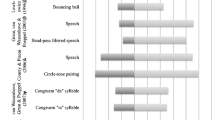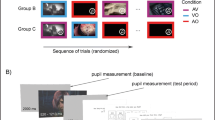Abstract
This paper is an extension of our previous work describing a novel methodology for quality assessment of long duration audiovisual content. In this article we focus on data analysis of results obtained from two experiments conducted using the new methodology. In the first study, we found that the time dimension does not influence participants’ expectations with respect to perceived video quality and that a possible increase or decrease in acceptable quality level is rather directly related to the presented material itself. Moreover, we found that participants are less sensitive to quality changes when the process is controlled externally than when they are in charge of the quality adjustment. A second experiment (study 2) was performed to evaluate the effect of simultaneous quality changes in the two modalities (audio and video) which confirmed the previous results.










Similar content being viewed by others
References
Alpert T, Contin L (1997) DSCQE (Double Stimulus using a Continuous Quality Evaluation) experiment for the evaluation of the MPEG-4 VM on error robustness functionality. ISO/IEC – JTC1/SC29/WG11, MPEG 97/M1604
Bech S, Zacharov N (2006) Perceptual audio evaluation—theory, method and application
Borowiak A, Reiter U, Svensson UP (2012) Quality evaluation of long duration audiovisual content. The 9th Annual IEEE Consumer Communications and Networking Conference—Special Session on Quality of Experience (QoE) for Multimedia Communications, Las Vegas, pp 353–357
Borowiak A, Reiter U, Svensson UP (2013) Evaluation of audio quality requirements over extended periods of time using long duration audiovisual content—cross modal perception. J Signal Process Syst. doi:10.1007/s11265-013-0777-8
Chen KT, Wu CC, Chang YC, Lei CL (2009) A crowdsourceable QoE evaluation framework for multimedia content . In: Proc. of the 17th ACM international conference on Multimedia, Beijing, pp 491–500
Fechner GT (1966) Elements of psychophysics (vol. 1). Original work published in 1860. Translated by H.E. Adler Holt, Rinehart and Winston, New York
Ghinea G, Chen SY (2003) The impact of cognitive styles on perceptual distributed multimedia quality. Br J Educ Technol 34(4):393–406
Hamberg R, de Ridder H (1995) Continuous assessment of perceptual image quality. J Opt Soc Am A 12:2573–2577
ITU-R (2009) Methodology for the subjective assessment of the quality of television pictures BT.500-12
ITU-T Rec. P.910 (1999) Subjective video quality assessment methods for multimedia applications. Int. Telecomm, Union
ITU-T Rec. P911 (1998) Subjective audiovisual quality assessment methods for multimedia applications. Int. Telecomm, Union
L.A.M.E (Lame Ain’t an MP3 Encoder)—The Hydrogenaudio recommended MP3 encoder. http://lame.sourceforge.net
Pinson M, Wolf S (2003) Comparing subjective video quality testing methodologies. In: Visual Communications and Image Processing 2003. Proc SPIE 5150:573–582
Reiter U (2010) Towards a classification of audiovisual media content. In: Proc. of the 129th Convention of the Audio Engineering Society. AES, San Francisco, USA
Rossi P, Gilula Z, Allenby G (2001) Overcoming scale usage heterogeneity: a Bayesian hierarchical approach. J Am Stat Assoc 96(453):20–31
Wang H, Qian X, Liu G (2010) Inter mode decision based on just noticeable difference Profile. In: Proc. of 2010 I.E. 17th International Conference on Image Processing, Hong Kong
Watson A, Sasse MA (1998) Measuring perceived quality of speech and video in multimedia conferencing applications. In: Proc. of ACM Multimedia 1998, ACM, pp 55–60
Winkler S, Dufaux F (2003) Video quality evaluation for mobile applications. Proc SPIE/IS&T Vis Commun Image Proc Conf 5150:593–603
Yang X, Tan Y, Ling N (2006) Rate control for H.264 with two-step quantization parameter determination but single-pass encoding. EURASIP J Appl Sig Process :1–13
Zajonc RB (1980) Feeling and thinking: preferences need no inferences. Am Psychol 35(2):151–175
Acknowledgments
This work was performed within the PERCEVAL project, funded by The Research Council of Norway under project number 193034/S10.
Author information
Authors and Affiliations
Corresponding author
Rights and permissions
About this article
Cite this article
Borowiak, A., Reiter, U. Quality evaluation of long duration AV content—an extended analysis using a novel assessment methodology. Multimed Tools Appl 74, 367–380 (2015). https://doi.org/10.1007/s11042-014-1920-7
Published:
Issue Date:
DOI: https://doi.org/10.1007/s11042-014-1920-7




